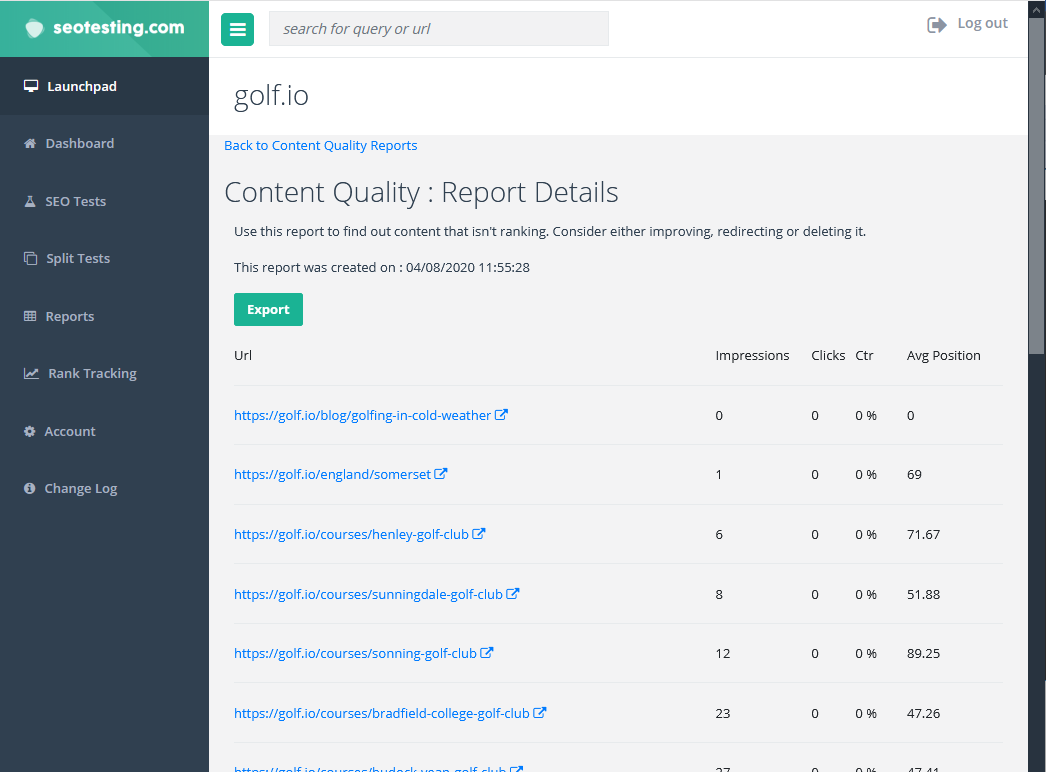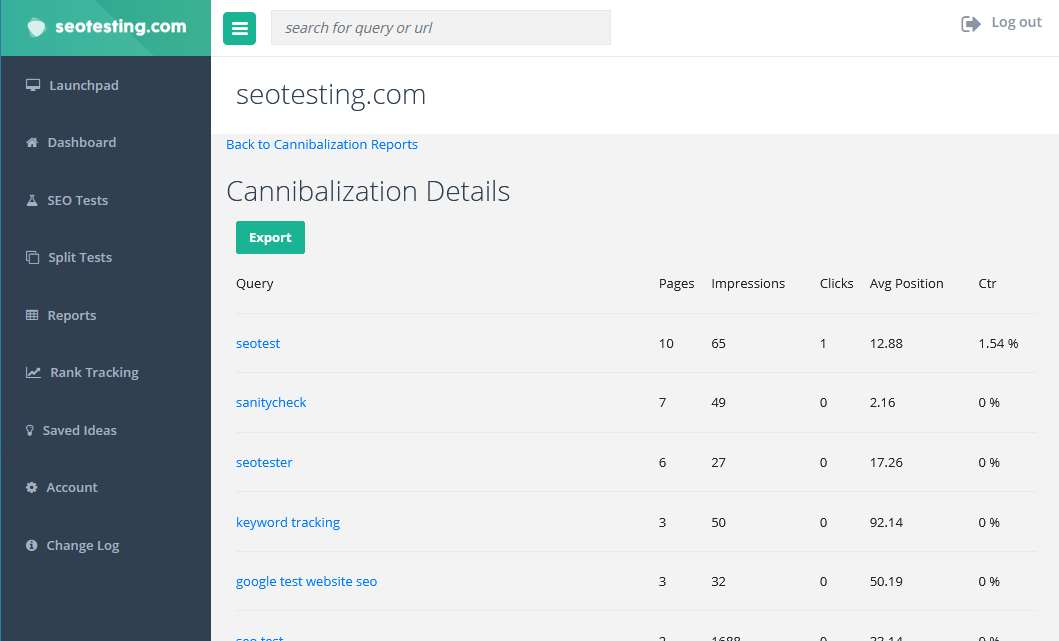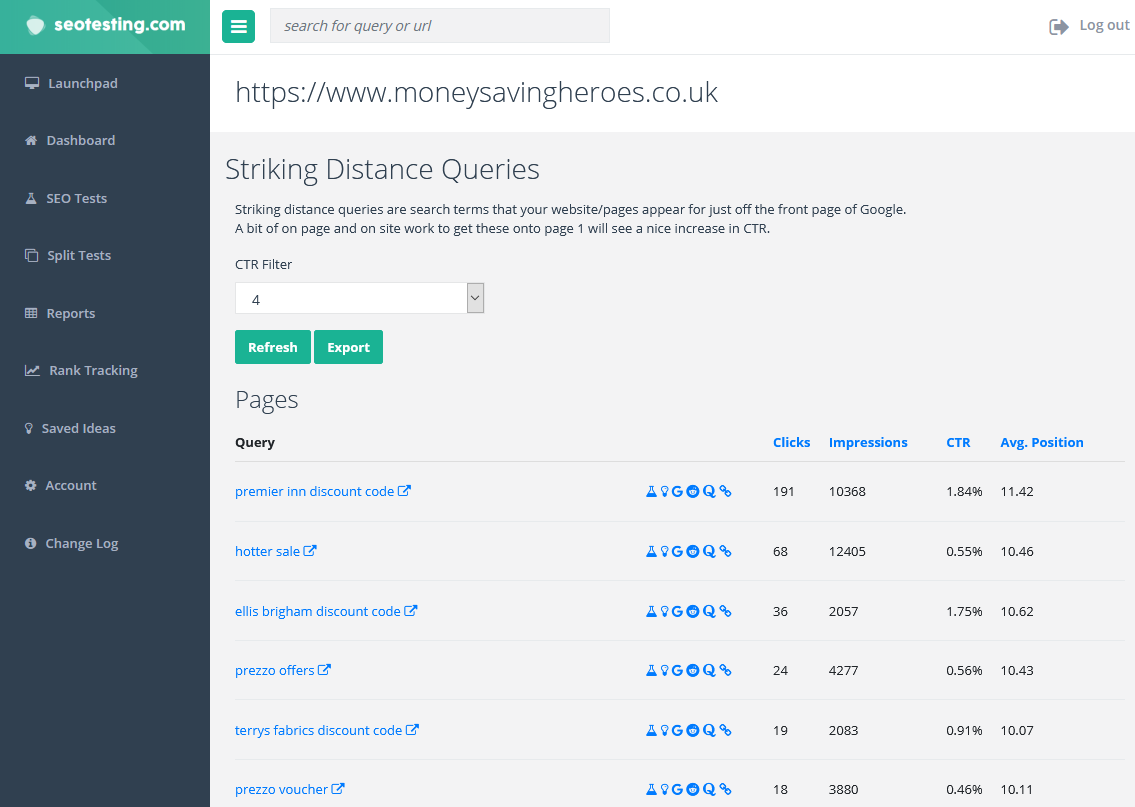For an established site, reviewing the content on your website can be quite a hefty challenge. Over time, content can become outdated, irrelevant, and overpowered by competitor content. Additionally, as content teams mature in size, expertise, and structure, your quality guidelines, formatting, and other aspects of published content may have changed.
Thus, the need for a content audit.
What is a content audit?
Specifically regarding SEO, a content audit is an SEO task in which you evaluate the current content on your website, blog and landing pages. You can include everything from body content to titles and descriptions, header tags, structured data, and ALT tags. Basically, anything that includes content can be addressed throughout this exercise.
It can also be helpful to review other content types such as your email and social media. Look for consistency and opportunities to influence how your social media users are searching for your content and interacting with your brand.
But, that’s another subject for another time.
Here are some great examples of why you might decide to perform a content audit for your website:
- You want to find content that is performing poorly in organic search.
- You want to find opportunities to improve existing content.
- You want to find new opportunities for new topics.
- You want to create topic clusters from existing content or content gaps.
Why is a content audit useful?
A content audit can help you understand how your efforts have impacted your website thus far. You’ll be able to see what content is working or not working, any issues with your pages (like content cannibalization), and how you can improve your content to stay in alignment with your current business goals.
The main purpose of your content audit is to learn how you can improve your website by optimizing the content you already have and by adding or removing any content based on your findings.
Content audits can also provide direction at specific milestones. Every 6 months, for example, you can evaluate what to focus on next to remain focused on your customer and competitive in your niche.

“Doing SEO content audits helps us identify key opportunities for optimizing our website content. By doing a thorough competitor and keyword gap analysis, we are able to focus on keywords and topics that bring in quality organic traffic, drive conversions, and increase revenue. Mapping topics for client avatars at different stages of the buyer’s journey and keeping search intent and SEO best practices in mind also helps bring value to our readers, which ultimately increases brand awareness and customer loyalty.”
When to perform a content audit
Content audits are performed after your site has already been active for a certain amount of time (usually 3-6 months minimum) and you’re looking to review and improve the efforts you’ve already made.
If you’re just starting from scratch, you won’t have enough data to perform a content audit. Instead, you’ll want to perform keyword research and create an outline of your website based on that research, your business objectives, and other factors.
Remember, you’ll want to perform a content audit when:
- Your site is already established (at least 3-6 months).
- Your site is ready for regular maintenance. We recommend once a quarter, or at least once every 6 months.
What to look for in a content audit
Before you start your audit and as you’re going through the exercise, here are some of the things to look for:
- Poor performing content
- Top performing content
- Content with low CTR (Clickthrough Rate)
- Thin Content
- Outdated Content
- Content Cannibalization
- Striking Distance Keywords
- Pages with a high bounce rate
- Confusing Pages
- Interlinking Opportunities
- Content Gaps
- Unexplored topics
- Duplicate Pages
- Off-brand content
- Content with missing header tags
- Difficult to read content
- Missing ALT tags
- Poor or missing structured data
While there’s a lot to look for throughout your audit, remember that you can isolate a particular area of the content audit, depending on your access to resources and your timeline.
For example, it might be easier to only focus on poor-performing content, then go back later to address keyword cannibalization. It’s perfectly okay to pick a specific focus for your audit if you’re in a crunch for time or if you prefer to work that way.
Ultimately, remember that your content audit is looking for areas of improvement. You can create a dashboard and review your GA and GSC data to see any of the items mentioned above, then evaluate which pages need which improvements.
Tory Gray, from The Gray Dot Company, explains her process.

“[For a content audit], I typically create a dashboard of results by URL, pulling in metrics from GA (Sessions and Conversion data for all users and organic users), GSC (Impressions & Clicks), and Ahrefs (Backlink data), plus normal SEO things like the title, description, H1, and word count. Then, I use filters and ordering to identify non-performers across all metrics; those are prime targets for removal.
I pull in all user data and organic data to ensure I’m thinking through business value, not just SEO value. High business value but low SEO value likely means we work to improve a page, for example. Clients are a lot more comfortable removing content that has driven little-to-no total traffic or conversions vs. just low-SEO-performers.
The dashboard also helps content marketers identify top performers, for a deeper analysis on why they perform well, so we can replicate those wins across more content. And vice versa – what are content things we attempted, that just truly aren’t working, so we can let them go?
Another point would be to clarify that the dashboard is intended as a starting point, not a final plan. This data can and should be married with Editorial, Brand, and CRO expertise (as needed) to make it really viable.
To do this, we present the dashboard to the various stakeholders and work with them to incorporate their own data points – like pointing out articles that aren’t well-aligned with the target audience, or the tone is wrong, it’s really dated, etc…
Cannibalization data is great to pull in when possible… Anything that’s cannibalized (that’s not due to brand) would get a deeper dive.”
That said, here’s a deeper dive into some of the items you’ll want to look into, and which reports in SEOTesting.com can help you…
Poor Performing Content
One thing you’ll want to look for in your audit is poor-performing content. There are several ways to do this.
At SEOtesting.com, the Content Quality Report makes it easy to find which pages have the lowest clicks and impressions within the last 90 days.

Use the Content Quality Report from SEOTesting.com to quickly find out which pages get limited impressions and clicks in the SERP.
You can also use Google Analytics and Google Search Console directly, or connect them to a tool like ScreamingFrog or Sitebulb to see which pages contribute to the largest and smallest number of impressions and clicks.
As you’re reviewing your Content Quality Report, look to see which pages you’ll want to improve, redirect, or delete.
Here’s what to do:
- Use the Content Quality Report to find content with little-to-no impressions or clicks.
- Decide what to do with those pages: Rewrite, expand, add to a cluster, merge, delete, or reuse.
- Check search intent. Perhaps there’s a mismatch in what you wrote versus what people are finding (or not finding) in your content.
- Finally, remember to consider the page category. For example, how did the branded content perform versus the blog pages? How are the category pages performing versus the product pages? You’ll want to take a look at these smaller segments in addition to understanding the site from a top-level.
Content Cannibalization
Often, SEO teams get into the habit of focusing solely on ranking for specific keywords.
When that happens, the content team is directed to create the same or similar content, again and again, targeting the same keywords and thus, creating competing content within its own content pool.
This is called content cannibalization or keyword cannibalization. Essentially, it’s content that competes with itself for the same keywords. Your content audit can help you find which content is competing with itself.
The Cannibalization Report in our SEO Testing tool can easily show you which pages compete for the same keywords across your entire site. You can use this report to understand which content could be merged, internally linked, reused, removed, or organized differently to reduce the number of competing keywords.

Easily see which pages are competing with the same keyword across all your content.
Here’s what to do with your keyword cannibalization findings:
- Merge competing pages.
- Reorganize content into content clusters.
- Remove repetitive content.
- Expand or revise to differentiate overlapping content.
- Create stronger interlinking.
Ultimately, your cannibalization report should help you find areas where you can create stronger relevance for fewer content pieces.

Low CTR
What might you look at when attempting to improve the click-through rate? First, understand what is and how it’s affected.
CTR is the number of clicks your page received compared to its number of impressions. So, if you had a high number of impressions, but think you should have received more clicks, there are a few steps you can take.
Here’s how to address low CTR:
- Review the SERP results.
- Check for intent. Perhaps you didn’t address the searcher’s question or there’s a mismatch in what users expect versus what they find on the page.
- Check for optimization opportunities in your titles, descriptions, and since Google’s most recent update to page title appearance, your header tags.
With the Top Query Per Page Report, you can easily see which queries correspond with which page. This will give you an opportunity to understand if you’re matching search intent, or if you can optimize your titles, descriptions, ALT tags, or header tags further.

Easily see which pages are competing with the same keyword across all your content.
Striking Distance Keywords
What are striking distance keywords? Striking distance keywords are keywords your website ranks for on page 2 or 3. In other words, they are within striking distance of appearing on page 1 for a target query.
During your content audit, you should check to see which pages are just shy of reaching the 1st page in the search results for your desired keyword.
Here’s what the Striking Distance Keywords Report looks like at seotesting.com.

What to do with your content after finding your striking distance keywords:
- Expand your content.
- Refresh your content.
- Create supporting content.
- Improve internal linking to the target page.

High Bounce Rate
Lastly, use your content audit to see which pages have a high bounce rate, or instances where users only interact with that page versus multiple pages.
If you’re using GA4, you can review the Average Engagement Time versus Bounce Rate to a similar effect.
This could indicate that your content lacks engagement, is not what the user was looking for, or that you’re missing opportunities to convert your customers.
How to find and act on a high bounce rate:
- Use Google Analytics to find your bounce rate across all pages. Go to Behavior > Site Content > All Pages. Then, click “Bounce Rate” to sort by bounce rate. You can export the data depending on how many pages you’re reviewing in your content audit.
- Use your overall site bounce rate as your baseline, then find the pages that exceed that amount.
- Make sure you’re looking at pages that have a decent amount of clicks and are the appropriate content type. For example, pages that are designed to be a one-stop content piece, like a specific “How to” blog, may naturally have a higher bounce rate. Consider the average bounce rate per content type.
- Review the pages with high bounce rates and decent traffic to narrow in on the content that needs reevaluating.
Turn Content Audit Findings into Measurable Tests
After your content audit is complete, you should have an idea of what content needs changing and why. What you’ll want to do now is test those changes to see if your optimizations led to measurable increases (or decreases) in performance.

“A successful audit requires a balance of strategic business thinking, SEO expertise, and communication skills. Audit templates or checklists can be used to have a full overview of possible issues that may arise. However, at the end of the day, the selection of the checks made and the prioritization of the tasks in the delivery sheet must be aligned with the specifics of the situation. If one is not able to transfer the impact of the implementation of each activity to the client, an audit is a worthless investment.”
Here’s what you’ll do to make sure your content audit has an impact:
- Select a content piece that you want to change.
- Set a hypothesis for what you are changing, why you are making the change, and what results you expect to see from the change.
- Set up your test in your SEOtesting.com account to easily track the results of your changes.
- Publish your content updates.
- Measure the results of your changes.
- Roll-out findings across additional content pieces as needed.
It’s true, content audits are tough work. Sometimes they involve not only the SEO team but clients as well. It’s easy for clients to get attached to the way things have always been done, but it’s usually worth exploring what aspects your of content need improving.

We find that our clients become very protective about the content they’ve created, which is human nature and understandable. They’ve invested time and money into creating the content, so it’s difficult for them to part with it. We try to limit subjective opinions about a piece of content. We do that by combining quantitative data (i.e. content inventory together with page views, CTRs, conversions, etc.) with qualitative data (is the content up-to-date, who’s the audience, stage in the funnel, is the purpose of the page clear, etc.).
Quantitative data takes the emotion out but doesn’t tell the full story. We’ve had clients who want to skip the qualitative analysis because it’s ‘too much work’. But this is a critical step as this information helps us determine if a piece of content’s poor performance could be due to issues such as being out of date, doesn’t meet user intent, and so on. Conversely, our analysis might find a strong performing piece of content but doesn’t suit the target audience or it’s no longer relevant to the business, in which case the content has to go. We then give each piece of content a final grade of: “bin it,” “keep as is,” “clean up” or “combine it” (take the good bits and add to another page).
Frequently Asked Questions
What is a content audit?
A content audit is the process of evaluating existing content on your website to identify what’s working, what needs updating, and what should be removed, consolidated, or improved — especially for SEO performance.
When should I perform a content audit?
You should perform a content audit once your site has been live for at least 3–6 months. Ongoing audits are recommended every 3 to 6 months, or quarterly for large sites.
Why is a content audit important for SEO?
Content audits help you find underperforming or outdated content, improve search visibility, prevent content cannibalization, and identify new opportunities for optimization and topic targeting.
What tools can help me perform a content audit?
You can use a combination of Google Analytics, Google Search Console, and SEOTesting.com — which offers purpose-built reports like the Content Quality Report, Cannibalization Report, and Striking Distance Keywords Report.
What types of issues should I look for in a content audit?
Common issues include:
- Thin or outdated content
- Keyword cannibalization
- Low CTR
- Content gaps
- High bounce rate
- Missing ALT or header tags
- Poor internal linking
- Duplicate or off-brand content
What reports in SEOTesting are most useful for content audits?
- Content Quality Report: Finds low-impression, low-click pages.
- Cannibalization Report: Highlights overlapping keyword content.
- Top Query Per Page: Reveals CTR issues and intent mismatches.
- Striking Distance Keywords: Shows content near page 1 rankings.
How can I measure the impact of content changes?
Use SEOTesting to run time-based tests or split tests after making changes. You can annotate changes and compare performance before and after to validate improvements.
Conclusion
Whether you’re looking to rebrand, improve site performance, or see where your next content opportunities might be hiding, a content audit is useful for gauging where you are now and where you’re headed in the future.
An important thing to remember is to track and measure the impact of your content audit changes. You can use split tests, time-based tests, and annotations to measure, track, and compare results until your next audit.
Did you find this helpful? Pass this along to help your team prepare for the next big content audit.
SEOTesting.com is an SEO tool aimed at helping you take action, track changes, and measure results from your GSC data. Check out all the features here and on our blog.


